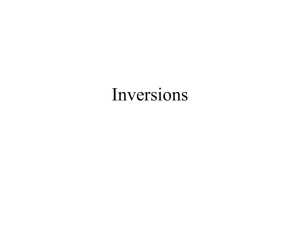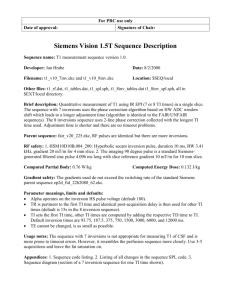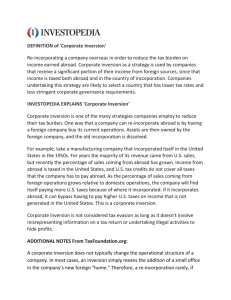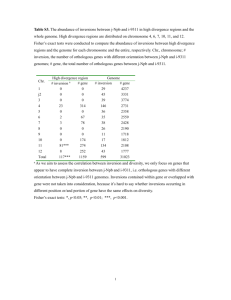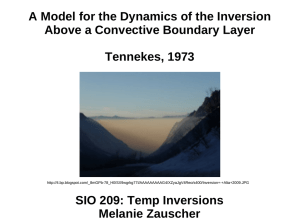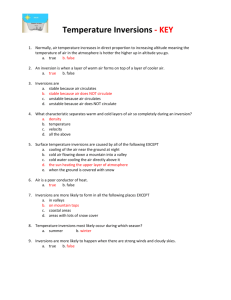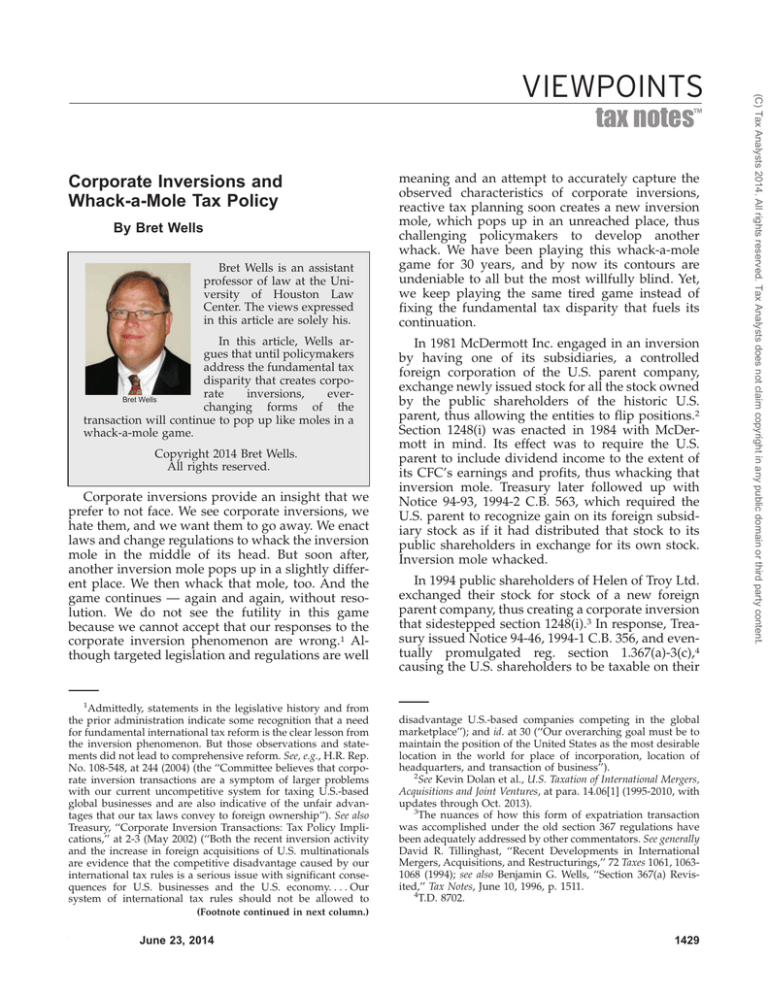
tax notes™
Corporate Inversions and
Whack-a-Mole Tax Policy
By Bret Wells
Bret Wells is an assistant
professor of law at the University of Houston Law
Center. The views expressed
in this article are solely his.
In this article, Wells argues that until policymakers
address the fundamental tax
disparity that creates corporate
inversions,
everBret Wells
changing forms of the
transaction will continue to pop up like moles in a
whack-a-mole game.
Copyright 2014 Bret Wells.
All rights reserved.
Corporate inversions provide an insight that we
prefer to not face. We see corporate inversions, we
hate them, and we want them to go away. We enact
laws and change regulations to whack the inversion
mole in the middle of its head. But soon after,
another inversion mole pops up in a slightly different place. We then whack that mole, too. And the
game continues — again and again, without resolution. We do not see the futility in this game
because we cannot accept that our responses to the
corporate inversion phenomenon are wrong.1 Although targeted legislation and regulations are well
1
Admittedly, statements in the legislative history and from
the prior administration indicate some recognition that a need
for fundamental international tax reform is the clear lesson from
the inversion phenomenon. But those observations and statements did not lead to comprehensive reform. See, e.g., H.R. Rep.
No. 108-548, at 244 (2004) (the ‘‘Committee believes that corporate inversion transactions are a symptom of larger problems
with our current uncompetitive system for taxing U.S.-based
global businesses and are also indicative of the unfair advantages that our tax laws convey to foreign ownership’’). See also
Treasury, ‘‘Corporate Inversion Transactions: Tax Policy Implications,’’ at 2-3 (May 2002) (‘‘Both the recent inversion activity
and the increase in foreign acquisitions of U.S. multinationals
are evidence that the competitive disadvantage caused by our
international tax rules is a serious issue with significant consequences for U.S. businesses and the U.S. economy. . . . Our
system of international tax rules should not be allowed to
meaning and an attempt to accurately capture the
observed characteristics of corporate inversions,
reactive tax planning soon creates a new inversion
mole, which pops up in an unreached place, thus
challenging policymakers to develop another
whack. We have been playing this whack-a-mole
game for 30 years, and by now its contours are
undeniable to all but the most willfully blind. Yet,
we keep playing the same tired game instead of
fixing the fundamental tax disparity that fuels its
continuation.
In 1981 McDermott Inc. engaged in an inversion
by having one of its subsidiaries, a controlled
foreign corporation of the U.S. parent company,
exchange newly issued stock for all the stock owned
by the public shareholders of the historic U.S.
parent, thus allowing the entities to flip positions.2
Section 1248(i) was enacted in 1984 with McDermott in mind. Its effect was to require the U.S.
parent to include dividend income to the extent of
its CFC’s earnings and profits, thus whacking that
inversion mole. Treasury later followed up with
Notice 94-93, 1994-2 C.B. 563, which required the
U.S. parent to recognize gain on its foreign subsidiary stock as if it had distributed that stock to its
public shareholders in exchange for its own stock.
Inversion mole whacked.
In 1994 public shareholders of Helen of Troy Ltd.
exchanged their stock for stock of a new foreign
parent company, thus creating a corporate inversion
that sidestepped section 1248(i).3 In response, Treasury issued Notice 94-46, 1994-1 C.B. 356, and eventually promulgated reg. section 1.367(a)-3(c),4
causing the U.S. shareholders to be taxable on their
disadvantage U.S.-based companies competing in the global
marketplace’’); and id. at 30 (‘‘Our overarching goal must be to
maintain the position of the United States as the most desirable
location in the world for place of incorporation, location of
headquarters, and transaction of business’’).
2
See Kevin Dolan et al., U.S. Taxation of International Mergers,
Acquisitions and Joint Ventures, at para. 14.06[1] (1995-2010, with
updates through Oct. 2013).
3
The nuances of how this form of expatriation transaction
was accomplished under the old section 367 regulations have
been adequately addressed by other commentators. See generally
David R. Tillinghast, ‘‘Recent Developments in International
Mergers, Acquisitions, and Restructurings,’’ 72 Taxes 1061, 10631068 (1994); see also Benjamin G. Wells, ‘‘Section 367(a) Revisited,’’ Tax Notes, June 10, 1996, p. 1511.
4
T.D. 8702.
(Footnote continued in next column.)
TAX NOTES, June 23, 2014
1429
(C) Tax Analysts 2014. All rights reserved. Tax Analysts does not claim copyright in any public domain or third party content.
VIEWPOINTS
COMMENTARY / VIEWPOINTS
But two new varieties of inversion moles popped
up. In 2010 Valeant Pharmaceuticals engaged in a
corporate inversion in which its shareholders received a special dividend immediately before being
acquired by Biovail, a Canadian corporation.5 The
pre-merger special dividend decreased the value of
Valeant, thus allowing the Valeant shareholders to
own slightly less than 50 percent of the postacquisition combined company.6 Reg. section
1.367(a)-3(c) provides rules against stuffing value to
make the foreign corporation bigger, but those
regulations do not prevent the U.S. group from
getting thinner.7 This slim-down technique has not
elicited a policy response. But a more frequent
inversion mole did. The government was forced to
react to a wave of naked inversion transactions in
2002,8 in which shareholder-level taxation was not a
significant friction cost. These included the standalone naked inversions of Cooper Industries,9 Nabors Industries Ltd.,10 Weatherford International,11
5
See Valeant and Biovail, DEF-14A, ‘‘Joint Proxy Statement,’’
at 2, 102-104 (Aug. 20, 2010) (stating that historic Biovail
shareholders are expected to own 50.5 percent post-merger and
describing how the reorganization is expected to be tax free
under section 367(a); Biovail, Form 8-K, ‘‘Current Report’’ (Sept.
28, 2010) (stating that shareholders approved the merger of
Valeant on Sept. 27, 2010, and describing the completion of the
merger and special dividend).
6
See Biovail, DEF-14A, ‘‘Proxy Statement,’’ at 2 (Aug. 23,
2010) (stating that historic Biovail shareholders are expected to
own 50.5 percent post-merger).
7
See reg. section 1.367(a)-3(c)(3)(iii)(B)(1).
8
These transactions are naked in the sense that nothing
operationally changed as a result of the inversions except the
location of the ultimate parent company and potentially the
senior corporate officers. Thus, the corporate inversion is
stripped bare of any nontax business reason to engage in the
transaction. These naked inversions are intolerable because they
provide no plausible deniability that the U.S. tax system is
discriminatory and that companies will reinvent themselves
because of the level of discrimination in the existing rules. This
point is made more fully in Bret Wells, ‘‘Cant and the Inconvenient Truth About Corporate Inversions,’’ Tax Notes, July 23,
2012, p. 429.
9
Cooper Industries, Form S-4, ‘‘Registration Statement’’
(Sept. 6, 2002); Cooper Industries, Form 8-K, ‘‘Current Report’’
(May 22, 2002) (announcing the completion of the corporate
inversion in Bermuda).
10
Nabors Industries Inc., Form S-4/A, ‘‘Registration Statement’’ (Apr. 29, 2002) (announcing intended corporate inversion); Nabors Industries, Form 8-K, ‘‘Current Report’’ (June 24,
2002) (announcing favorable shareholder vote and completion
of corporate inversion to Bermuda).
11
Weatherford International, DEF-14A, ‘‘Proxy Statement’’
(May 22, 2002) (announcing shareholder vote to approve corporate inversion); Weatherford International, Form 8-K, ‘‘Current
Seagate Technologies PLC,12 and Herbalife International.13 In each of those transactions, the new
foreign parent was incorporated in the Cayman
Islands or Bermuda while maintaining its tax residency in Barbados, thus entitling the foreign parent
to use the then-existing provisions of the BarbadosU.S. treaty.
In response, Congress enacted section 7874,
which would treat the new foreign parent as a U.S.
corporation for U.S. tax purposes unless either the
legacy shareholders of the U.S. corporation owned
less than 80 percent of the combined entity, or the
new foreign parent had a substantial business presence in the new foreign parent’s jurisdiction of
incorporation.14 Treasury issued regulations in June
2006 that defined the substantial business activities
standard, providing a facts-and-circumstances test
and a 10 percent safe harbor.15 And Treasury negotiated a protocol to the Barbados treaty to attack a
common inbound treaty structure used by recently
inverted companies. That protocol was ratified by
the Senate and eventually signed.16 Congress also
signaled that it might further restrict treaty benefits
in situations in which the ultimate parent company
was incorporated in a jurisdiction where it lacked a
substantial business presence.17
In combination, the proscriptions in new legislation, the tightening (and the threat of further
tightening) of the limitation on treaty benefits, and
the promulgation of new regulations to implement
section 7874 failed to stop corporate inversions
despite the multifaceted nature of this whack. As
Report’’ (June 26, 2002) (announcing favorable shareholder vote
and completion of corporate inversion).
12
See Seagate, Form S-4A, ‘‘Registration Statement’’ (Aug. 30,
2000); Seagate, Form 8-K, ‘‘Current Report’’ (Feb. 5, 2001)
(stating that shareholders approved the corporate inversion on
Nov. 22, 2000).
13
Herbalife International, PREM-14A, ‘‘Proxy Statement’’
(May 7, 2002) (announcing proposed corporate inversion to the
Cayman Islands); Herbalife International, Form 8-K, ‘‘Current
Report’’ (July 31, 2002) (announcing completion of corporate
inversion to the Cayman Islands).
14
See section 7874(a)(2)(B) and (b).
15
T.D. 9265.
16
Protocol to Barbados-U.S. Convention to Prevent Double
Taxation and Prevention of Fiscal Evasion (July 14, 2004).
17
See S. 96, Export Products Not Jobs Act, 110th Cong., 1st
Sess. (Jan. 4, 2007) (proposal introduced by then-Sen. John Kerry
to treat corporations incorporated outside the United States as
U.S. corporations if they are managed and controlled within the
United States); S. 3162, Manufacturing, Assembling, Development, and Export in the USA (MADE in the USA) Tax Act, 110th
Cong., 2d Sess. (June 19, 2008) (proposal introduced by thenSen. George V. Voinovich to include a management and control
test and restrict treaty benefits when the parent company is
incorporated in a jurisdiction without a substantial business
presence).
(Footnote continued in next column.)
1430
TAX NOTES, June 23, 2014
(C) Tax Analysts 2014. All rights reserved. Tax Analysts does not claim copyright in any public domain or third party content.
built-in gain if the legacy shareholders of the U.S.
parent owned more than 50 percent of the inverted
foreign parent company. Inversion mole whacked
again.
COMMENTARY / VIEWPOINTS
Treasury removed it from the regulations,30 thus
taking another whack at inversions.31
But the capital markets understand financial incentives, and there are significant financial incentives to be a foreign-owned multinational
enterprise. Tim Horton’s Inc.,32 Ensco Inc.,33 Aon
PLC,34 and Rowan Cos. Inc.35 all engaged in naked
inversion transactions based on the advice of tax
counsel, claiming that they had a substantial business presence in the country of incorporation of the
inverted parent company based on all the facts and
circumstances. In response, Treasury amended the
definition of substantial business presence in the
regulations to prospectively require that 25 percent
of the employees, sales, and assets of the combined
company be located in the jurisdiction of incorporation of the ultimate parent entity. But as the
recently announced inversion of Liberty Global
Inc.36 demonstrates, even this elevated standard can
be met in appropriate business combinations.
18
Covidien, Form 8-K, ‘‘Current Report’’ (May 28, 2009)
(announcing the migration of its parent company from Bermuda
to Switzerland).
19
Tyco International, Form 8-K, ‘‘Current Report’’ (Mar. 17,
2009) (announcing the migration of its parent company from
Bermuda to Switzerland).
20
Tyco Electronics, Form 8-K, ‘‘Current Report’’ (June 23,
2009) (announcing the re-domestication of its parent company
from Bermuda to Switzerland).
21
Foster Wheeler, Form 8-K, ‘‘Current Report’’ (Sept. 1, 2009)
(announcing shareholder approval to re-domesticate the corporate parent from Bermuda to Switzerland).
22
Transocean Inc., Form 8-K, ‘‘Current Report’’ (Oct. 31, 2009)
(announcing the re-domestication of its parent company from
the Cayman Islands to Switzerland).
23
Weatherford International, Form 8-K, ‘‘Current Report’’
(Feb. 28, 2009) (announcing the re-domestication of its parent
corporation from Bermuda to Switzerland).
24
ACE Ltd., Form 8-K, ‘‘Current Report’’ (July 10, 2008)
(announcing shareholder approval to re-domesticate the parent
company from the Cayman Islands to Switzerland).
25
Noble Corp., Form 8-K, ‘‘Current Report’’ (Mar. 26, 2009)
(announcing the re-domestication of the parent company from
the Cayman Islands to Switzerland).
26
Accenture, Form 8-K, ‘‘Current Report’’ (Sept. 1, 2009)
(announcing the completion of the re-domestication of the
parent company from Bermuda to Ireland).
27
Seagate, Form 8-K, ‘‘Current Report’’ (Apr. 14, 2009) (announcing the re-domestication of the parent company from the
Cayman Islands to Ireland).
28
Cooper Industries, Form 8-K, ‘‘Current Report’’ (June 18,
2009) (announcing the re-domestication of the parent company
from Bermuda to Ireland).
29
Ingersoll Rand, Form 8-K, ‘‘Current Report’’ (June 12, 2009)
(announcing that final approvals were received to effectuate the
migration of the corporate parent from Bermuda to Ireland).
TAX NOTES, June 23, 2014
30
See T.D. 9453. In the preamble to T.D. 9453, the IRS and
Treasury said they had concluded that the safe harbor provided
by the 2006 temporary regulations may apply to some transactions that are inconsistent with the purposes of section 7874 and
that the 2009 temporary regulations therefore did not retain the
safe harbor provided by the 2006 temporary regulations. The
2009 temporary regulations also do not retain the examples
illustrating the general rule in the 2006 temporary regulations.
Thus, after the issuance of the 2009 temporary regulations,
taxpayers could no longer rely on the safe harbor or on the
examples illustrating the general rule provided by the 2006
temporary regulations.
31
See Philip Tretiak and Patrick Jackman, ‘‘Code Section 7874:
Hotel California for U.S. Companies,’’ 35 Int’l Tax J. 5, 9 (2009)
(hypothesizing that the removal of the safe harbor coupled with
the statement in the preamble to T.D. 9453 that the substantial
business presence test was a no-rule area represents an effort by
the IRS to up the ante for outside counsel to opine on this area
of law).
32
Tim Horton’s Inc., Form DEFM 14A, ‘‘Proxy Statement,’’ at
22 (Aug. 18, 2009); Tim Horton’s, Form 8-K, ‘‘Current Report’’
(Sept. 22, 2009).
33
Ensco, Form DEFM 14A, ‘‘Proxy Statement,’’ at 15 (Nov. 20,
2009); Ensco, Form 8-K, ‘‘Current Report’’ (Dec. 1, 2009); Ensco,
Form 8-K12B, ‘‘Current Report’’ (Dec. 23, 2009).
34
Aon, ‘‘Prospectus for Special Shareholder Meeting of
March 18, 2012,’’ at 24, 61-62 (Feb. 6, 2012); Aon, Form 8-K12B,
‘‘Current Report’’ (Apr. 2, 2012).
35
Rowan, ‘‘Prospectus for Special Shareholder Meeting on
April 16, 2012,’’ at 33, 37-38, 54-55 (Mar. 8, 2012); Rowan, Form
8-K12B, ‘‘Current Report’’ (May 4, 2012).
36
See proxy statement of Liberty Global Inc., filed on Schedule 14A, at 168 (May 1, 2013).
1431
(C) Tax Analysts 2014. All rights reserved. Tax Analysts does not claim copyright in any public domain or third party content.
for the efforts to tighten U.S. tax treaties, potentially affected companies migrated out of the
Cayman Islands and Bermuda in 2008 and 2009 to
re-domicile in Switzerland (Covidien Ltd.,18 Tyco
International Ltd.,19 Tyco Electronics Ltd.,20 Foster
Wheeler AG,21 Transocean Ltd.,22 Weatherford
International,23 ACE Ltd.,24 and Noble Corp.25) or
to Ireland (Accenture PLC,26 Seagate,27 Cooper
Industries,28 and Ingersoll Rand29). Thus, significant treaty benefits for those inverted companies
remain despite Treasury’s efforts to incorporate
stricter limitations on treaty benefits. As for section
7874’s effect, several companies proposed to engage in naked inversions, claiming that they met
the 10 percent safe harbor provided in the existing
regulations. Angered by proposed inversions that
would safely navigate the 10 percent safe harbor,
COMMENTARY / VIEWPOINTS
37
Jefferson P. VanderWolk, ‘‘Inversions Under Section 7874 of
the Internal Revenue Code: Flawed Legislation, Flawed Guidance,’’ 30 Nw. J. Int’l L. & Bus. 699 (2010) (predicting that section
7874 would not prevent ongoing inversion transactions).
38
Eaton Corp. PLC, Form S-4/A, ‘‘Registration Statement’’
(Aug. 1, 2012) (announcing Eaton-Cooper merger in which new
parent entity will be incorporated in Ireland and the historic
U.S. shareholders of Eaton were expected to own approximately
73 percent of the combined entity).
39
ChiquitaFyffes Ltd., Form S-4, ‘‘Registration Statement’’
(Apr. 29, 2014) (announcing the proposed combination of Chiquita and Fyffes, with the historic U.S. shareholders of Chiquita
expected to receive 50.7 percent of the combined company).
40
See PXRE, Form S-4/A, ‘‘Joint Registration Statement of
PXRE and Argonaut’’ (June 8, 2007) (announcing the proposed
combination of Argonaut and PXRE, with the historic U.S.
shareholders of Argonaut expected to receive 73 percent of the
combined company); Argonaut Group Inc., Form 8-K, ‘‘Current
Report’’ (July 26, 2007) (announcing shareholder approval for
Argonaut’s merger into a wholly owned subsidiary of PXRE
Group Ltd.).
41
In a fascinating variation on this theme, Endo Health/
Paladin Labs and Liberty Global/Virgin Media used this technique in an outbound triangular reorganization that avoided the
strictures of reg. section 1.367(a)-3(c), but in Notice 2014-32,
2014-20 IRB 1006, Treasury said it was going to amend regulations to prevent this technique prospectively, thus whacking
that mole.
42
Marie Sapirie, ‘‘Pfizer and the Future of Inversions,’’ Tax
Notes, May 12, 2014, p. 635; Andrew Velarde, ‘‘High U.S. Tax
Rates Responsible for Pfizer Inversion, Camp Argues,’’ Tax
Notes, May 5, 2014, p. 537.
43
See Stop Corporate Inversions Act of 2014 (draft released
May 20, 2014), 13th Cong., 2d Sess.; Lindsey McPherson and
Velarde, ‘‘Democrats Disagree on Legislative Fix for Inversions,’’ Tax Notes, May 26, 2014, p. 876.
rejected Pfizer’s takeover attempt, momentum for
this legislation may have been lost, at least for
now.44
History should be our guide. It is undeniable that
substantial tax benefits (often more than $150 million annually for the inverted companies)45 are
available for a foreign-owned MNE. A recent report
indicates that an inversion of Walgreens could
reduce its U.S. taxes by $4 billion over a five-year
period.46 Potential tax savings of these magnitudes
make reactive tax planning inevitable. Whacking
the current form of the corporate inversion mole is
not an effective response to the inversion phenomenon (as good as it may feel to whack that mole
really hard) because it fails to address the enormous
tax disparity between U.S.-owned MNEs and
foreign-owned MNEs, which is what compels companies to search for the next generation of inversion
structures. Corporate inversions represent ‘‘voting
with one’s feet.’’ The United States cannot have a
tax system that treats similarly situated competitors
in the U.S. marketplace differently and not expect
the disfavored competitor, the U.S.-owned MNE, to
try to transform itself into the more favorable
foreign-owned MNE.
Wall Street is very good at reinventing companies, and it is telling Congress a simple truth:
current U.S. tax law provides a broader array of
opportunities to strip U.S. territorial profits out of
the U.S. tax base if the global business is structured
as a foreign-owned MNE. Corporate inversions are
the way for historically U.S.-owned MNEs to gain
access to the profit-shifting and earning-stripping
techniques available to inbound foreign-owned
MNE competitors.47 The U.S. tax treaty policy and
transfer pricing rules have been designed to minimize source country taxation and to maximize the
potential for eventual residency-based taxation.48
44
See Martin A. Sullivan, ‘‘Lessons From the Last War on
Inversions,’’ Tax Notes, May 26, 2014, p. 861.
45
See Stuart Webber, ‘‘Merging U.S. Firms Select European
Headquarters to Reduce Taxes,’’ Tax Notes Int’l, Mar. 31, 2014, p.
1223 (detailing the significant tax savings garnered by companies that have inverted in the past).
46
See Americans for Tax Fairness, Reporting on Offshoring
America’s Drugstore (June 11, 2014).
47
S. Rep. No. 108-192, at 142 (Nov. 7, 2003); see also Joint
Committee on Taxation, ‘‘General Explanation of Tax Legislation Enacted in the 108th Congress,’’ JCS-5-05, at 343 (May
2005); Treasury, ‘‘Report to Congress on Earnings Stripping,
Transfer Pricing, and U.S. Tax Treaties,’’ at 8 (Nov. 2007).
48
In the formative League of Nations debates over the model
treaty that would become the basis for the modern OECD and
UN model treaties, tax scholars predicted that all nations would
adopt worldwide tax regimes as they moved from semideveloped status to developed nation status. League of Nations,
‘‘Report on Double Taxation to the Financial Committee of the
(Footnote continued on next page.)
1432
TAX NOTES, June 23, 2014
(C) Tax Analysts 2014. All rights reserved. Tax Analysts does not claim copyright in any public domain or third party content.
Another common way to achieve corporate inversions is through foreign mergers and acquisitions in which the legacy shareholders of the U.S.
MNE own less than 80 percent of the combined
company.37 A wave of recent business combinations, including Eaton/Cooper,38 Chiquita/Fyffes,39
and Argonaut/PXRE40 used this technique. For tax
purposes, the smaller foreign company is the tax
acquirer of the larger U.S. company, and the management team that survives the business combination (or at least the location of the key corporate
officers) often remains in the United States.41 Congress recently reawakened to this type of corporate
inversion when Pfizer Inc., a behemoth company,
made a failed attempt to acquire a smaller competitor, AstraZeneca PLC.42 In response to this corporate inversion technique, a bill has been introduced
that would treat a foreign parent entity as a U.S.
corporation (thus denying inversion benefits) for a
new parent entity if more than 50 percent of its
shareholders are legacy shareholders of the U.S.
target company or if management and control of the
inverted parent company is located in the United
States.43 But because the AstraZeneca shareholders
COMMENTARY / VIEWPOINTS
League of Nations,’’ Doc. E.F.S. 73 F 19, at 51 (Apr. 5, 1923).
Thus, designing a system that allowed profits to migrate out of
source countries made sense to those thinkers, but it is woefully
inadequate for today’s world. A detailed analysis of the rationale for this unlevel playing field is comprehensively addressed
elsewhere. See Wells and Cym Lowell, ‘‘Homeless Income and
Tax Base Erosion: Source Is the Linchpin,’’ 65 Tax L. Rev. 365
(2012). For an analysis of how the U.S. transfer pricing rules
have been applied to create profit shifting, see Wells and Lowell,
‘‘Tax Base Erosion: Reformation of Section 482’s Arm’s-Length
Standard,’’ 15 Fla. Tax Rev. 737 (2014).
49
See Wells, ‘‘Territorial Tax Reform: Homeless Income Is the
Achilles Heel,’’ 12 Hous. Bus. & Tax L.J. 1 (2012).
50
For a further explanation of this statement, see Wells,
‘‘What Corporate Inversions Teach About International Tax
Reform,’’ Tax Notes, June 21, 2010, p. 1345.
51
See McPherson and Velarde, supra note 43; Ron Wyden,
‘‘We Must Stop Driving Businesses Out of the Country,’’ The
Wall Street Journal, May 8, 2014 (in reference to the Pfizer
proposed corporate inversion, Wyden said that ‘‘an uncompetitive tax code strains our economy, and we should not be
surprised when corporations fight to get out from under antiquated tax rules’’).
52
House Ways and Means Committee, 112th Cong., 1st Sess.,
Tax Reform Act of 2011, Title III, section 301-14 (Oct. 26, 2011)
(proposed draft); Ways and Means Committee, ‘‘Technical Explanation of the Ways and Means Discussion Draft Provisions to
Establish a Participation Exemption System for the Taxation of
Foreign Income,’’ I (Oct. 26, 2011).
53
See section 864(c).
fallen out of step with those other developed nations.54 But countries that have adopted territorial
tax regimes also typically have a robust VAT regime, and there is no momentum for the adoption
of a VAT regime in the United States.55 So if the
United States adopted a stand-alone territorial tax
regime, it would represent a unique approach.56
Further, a territorial tax regime provides equal
opportunity for all MNEs to engage in earnings
stripping.57 Thus, even though a territorial tax regime may be competitively neutral, it does not
address the tax base erosion opportunities available
to inbound activities of MNEs and in fact makes
those opportunities available for all MNEs. In the
end, the U.S. government needs a tax system that is
both competitively neutral and collects significant
revenue.
Thus, whether one is motivated by a desire to
stop corporate inversion transactions or by a desire
to develop a territorial tax regime that collects
significant revenue, the conclusion is the same: The
United States must comprehensively address the
base erosion advantages provided to inbound
foreign-based MNEs. The United States should better protect its source country right to tax profits that
originate from within its borders. In an earlier work,
Cym Lowell and I argued that the United States
should impose an upfront collection mechanism on
all related-party deductible payments and should
test all transfer pricing results for MNEs by using a
profit-split method to prevent the artificial assignment of residual profits to an offshore risk-taker
entrepreneurial entity.58 Others have proposed that
54
See JCT, ‘‘Background and Selected Issues Related to the
U.S. International Tax System That Exempt Foreign Business
Income,’’ JCX-33-11, at 1, 7-8 (May 20, 2011) (analyzing nine
major trading partners of the United States that provide for an
exemption system); see also JCT, ‘‘Present Law and Issues in U.S.
Taxation of Cross-Border Income,’’ JCX-42-11, at 1, 20, 72-73
(Sept. 6, 2011) (reviewing policy considerations between a
territorial and worldwide tax system).
55
For a thoughtful proposal to use the adoption of a VAT as
a replacement for significant portions of the existing income tax
and corporate tax, see Michael J. Graetz, 100 Million Unnecessary
Returns: A Simple, Fair, and Competitive Plan for the United States
(2010).
56
See Graetz, ‘‘The Tax Reform Road Not Taken — Yet,’’ 67
Nat’l Tax J. 419 (2014) (making this observation and arguing that
a destination-based VAT is an important element in future tax
reform).
57
For my detailed analysis of proposed territorial tax reform
measures, see Wells, supra note 49.
58
See Wells and Lowell, supra note 48. As we envisioned this
proposal, the upfront surtax on related-party base erosion
payments would act much like wage withholding. It is a
collection mechanism to collect tax on the residual profits that
are stripped out of the U.S. affiliate by base erosion payments.
We would suggest that no refund of this estimated tax be given
unless the U.S. portion of residual profits is shown to be less
(Footnote continued on next page.)
TAX NOTES, June 23, 2014
1433
(C) Tax Analysts 2014. All rights reserved. Tax Analysts does not claim copyright in any public domain or third party content.
The U.S. subpart F regime has served as a means to
backstop the U.S. tax base when this skewed application of our transfer pricing and treaty rules creates inappropriate profit-shifting opportunities.49
But the subpart F rules do not apply to foreignowned MNEs (including inverted foreign-owned
MNEs), so reliance on those residency-based taxation principles is an inadequate response to the base
erosion phenomenon highlighted by corporate inversions. Yet, Congress has stopped short of concluding that inverted companies are similarly
positioned to all other foreign-owned MNEs even
though inverted companies use the same earningstripping techniques available to foreign-owned
MNEs.50 Although there are now signs that legislators on both sides of the aisle recognize the need for
broader tax reform,51 that recognition has not led to
a robust reassessment of the U.S. inbound taxation
regime.
Some have claimed that broad international tax
reform should include the adoption of a territorial
tax regime.52 Foreign-based MNEs are generally
taxed in the United States only on the profits
attributable to their U.S. business activity (a territorial tax result).53 Seen in this context, corporate
inversions are a self-help way for U.S.-based MNEs
to create a de facto U.S. territorial tax regime for
themselves. Moreover, because many major trading
partners of the United States have adopted territorial tax regimes, the United States has arguably
COMMENTARY / VIEWPOINTS
than the presumptive amount using a residual profit-split
analysis in reg. section 1.482-6(c).
59
See Michael C. Durst, ‘‘Statutory Protection From Base
Erosion for Developing Countries,’’ Tax Notes, Jan. 28, 2013, p.
495.
60
See Reuven S. Avi-Yonah, ‘‘A Coordinated Withholding Tax
on Deductible Payments,’’ Tax Notes, June 2, 2008, p. 993.
61
See Avi-Yonah and Ilan Benshalom, ‘‘Formulary Apportionment: Myths and Prospects,’’ 2 World Tax J. 371 (2011);
Benshalom, ‘‘Taxing the Financial Income of Multinational
Enterprises by Employing a Hybrid Formulary and Arm’s
Length Allocation Method,’’ 28 Va. Tax Rev. 619 (2009); see also
Avi-Yonah, Kimberly A. Clausing, and Michael C. Durst, ‘‘Allocating Business Profits for Tax Purposes: A Proposal to Adopt
a Formulary Profit Split,’’ 9 Fla. Tax Rev. 497 (2009); Hearing on
Transfer Pricing Issues Before the Ways and Means Committee,
111th Cong. 8-10 (2010) (statement of Sullivan); but see Rosanne
Altshuler and Harry Grubert, ‘‘Formulary Apportionment: Is It
Better Than the Current System and Are There Better Alternatives?’’ 63 Nat’l Tax J. 1145, 1166-1167 (2010); Jane G. Gravelle,
‘‘Reform of U.S. International Taxation: Alternatives,’’ Congressional Research Service report (RL34115), at 13 (2010) (transfer
pricing rules would become more important in a territorial
system); James R. Hines Jr., ‘‘Income Misdistribution Under
Formula Apportionment,’’ 54 Eur. Econ. Rev. 108, 117-118 (2010)
(focusing on the proposed EU community consolidated tax
proposal with the allocation among countries; allocation factors
often used do not reflect how business income is generated).
1434
attention to protecting the U.S. tax base against
earnings-stripping techniques that exist in the inbound related-party foreign-owned MNE context.
Failing to do so creates an unacceptable disparity in
how similarly situated MNEs are taxed on their U.S.
origin profits under current law. Corporate inversions will not go away until the tax burden on
income earned from within the United States is
similar in amount whether earned by a foreignbased or U.S.-based MNE.62
Instead of continuing our historic responses to
corporate inversions, which are akin to the whacka-mole game, policymakers should instead address
the base erosion and profit-shifting advantages afforded to inbound foreign-owned MNEs, since that
tax advantage is what fuels these transactions.
Thus, policymakers need to adopt reform measures
that seek to eliminate the significant tax advantages
given to foreign ownership of U.S. business activities in order to equalize the playing field between
U.S.-based MNEs and foreign-based MNEs. This is
the fundamental lesson we are overdue to learn
from the corporate inversion phenomenon.
62
Treasury has observed that ‘‘the ability to reduce overall
taxes on U.S. operations through these income shifting techniques provides an immediate and quantifiable benefit. . . . [T]he decision to enter into the inversion may be
dependent in many cases upon the immediate expected reduction in U.S. tax on income from U.S. operations.’’ See Treasury,
supra note 47, at 8.
TAX NOTES, June 23, 2014
(C) Tax Analysts 2014. All rights reserved. Tax Analysts does not claim copyright in any public domain or third party content.
the United States disallow deductions for relatedparty payments made to tax haven affiliates59 or
impose a final withholding tax on those payments.60 And others have suggested that the United
States adopt a formulary apportionment method for
MNEs.61 Regardless of the specific recommendation, it is time for Congress to devote significant


